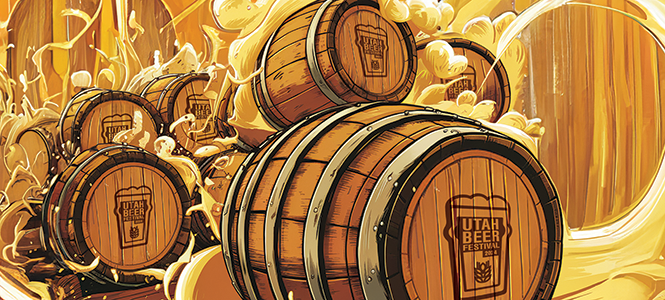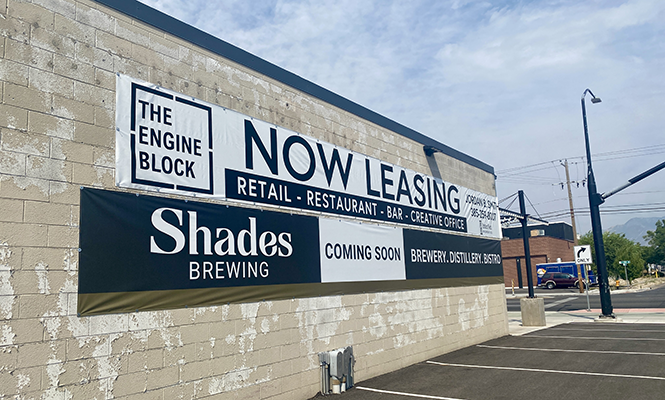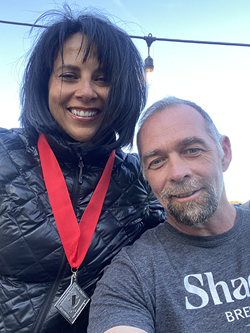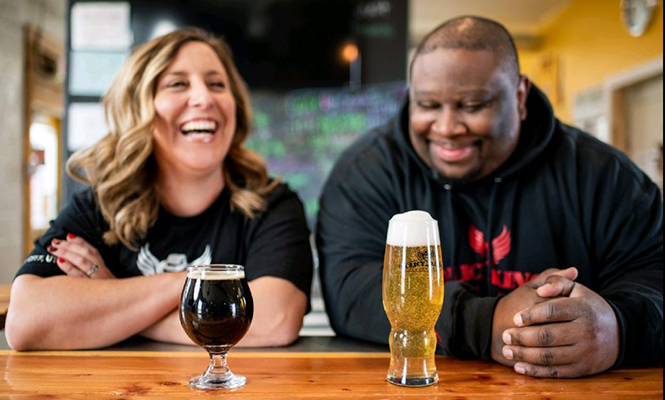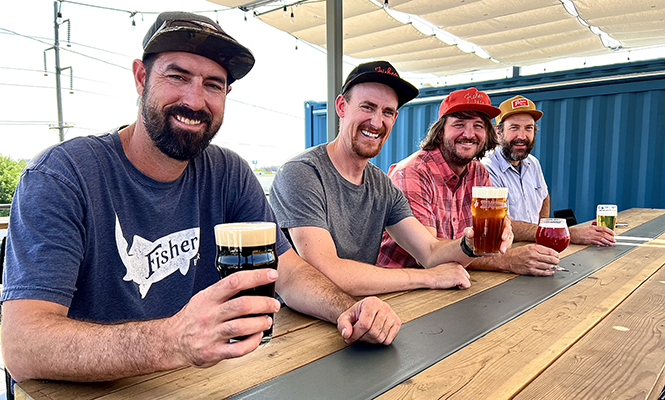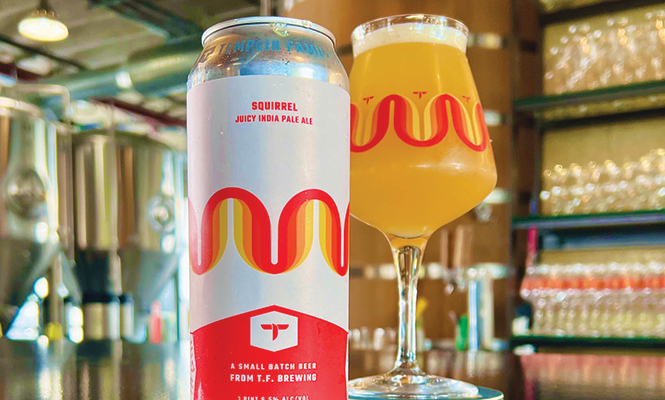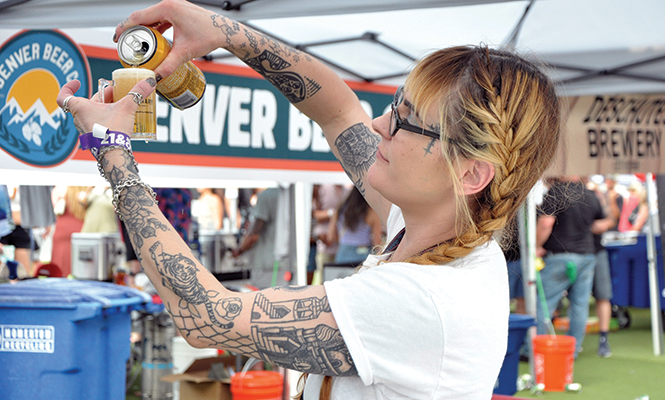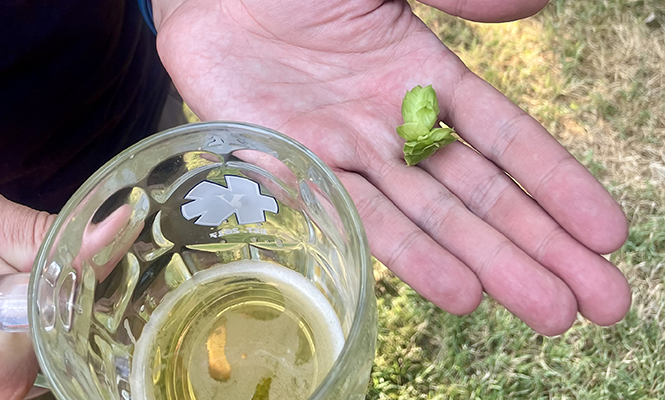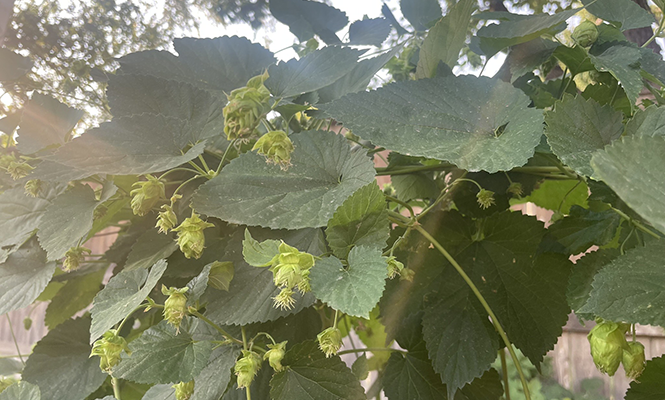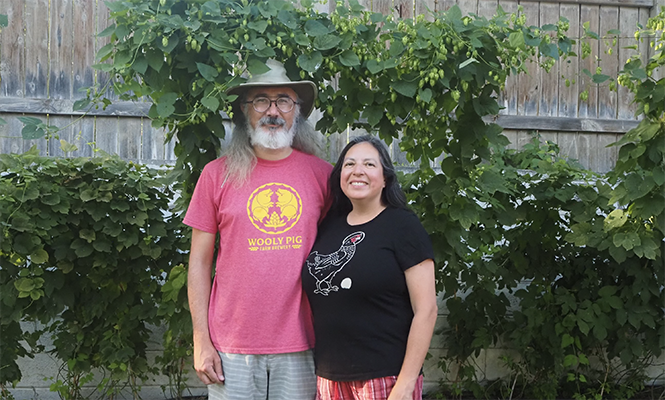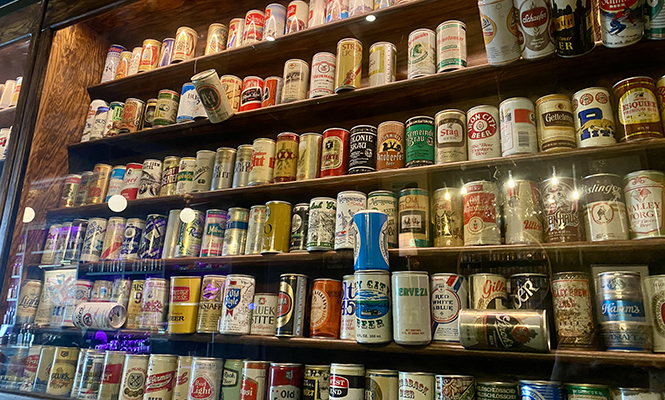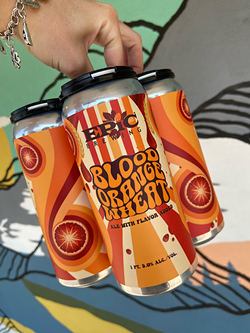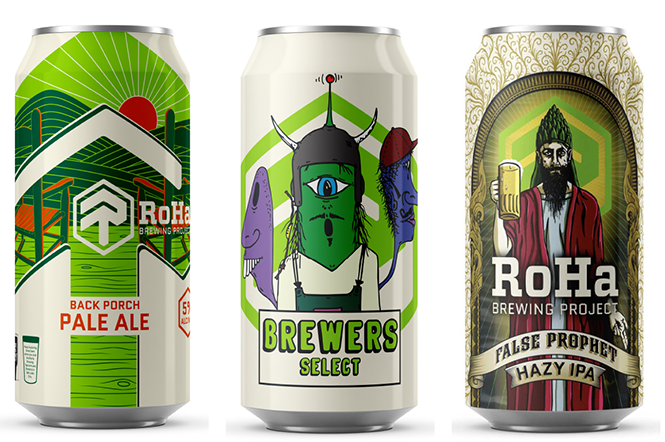CW's 2024 Beer Issue breaks down local brew news, beer can art, hop foraging and the 14th annual Utah Beer Festival.
Roll Out the Barrels
By Mike Riedel @utahbeer, Erin Moore @errrands_, Thomas Crone and Benjamin Wood @BjaminWoodIt's been 14 years since City Weekly's first Utah Beer Festival. As we put the finishing touches in place for another great weekend at The Gateway (see page 28), I can't help but stop and think about how far Salt Lake City has come and how large a role our friends in the brewing industry played in that progress.
In the pages that follow, resident Beer Nerd Mike Riedel describes some of the expansion efforts underway or recently completed by the folks at Fisher Beer, Shades Brewing and Policy Kings, as well as the national and international accolades being heaped on the Templin Family. It recalls to mind what The Granary district looked like 14 years ago (if you don't remember, you haven't forgotten much), where Fisher and TF have been crushing it while a neighborhood blossoms around them. Same story for Central Ninth, where Policy Kings will soon open its doors, a stone's throw from fellow beverage stalwarts like Scion Cider, Water Witch, Hoppers Brewing and the incoming Thieves Guild Cidery.
Down the road in Ballpark, Shades is helping to transform a neglected slice of the city into a new hot spot, adding energy and vibrancy to 300 West after doing much the same thing with its great downtown space on State Street.
And these are just the few examples highlighted in this year's issue, as there's simply too much quality work and excitement to capture: Granary pioneer Kiitos is expanding into Sugar House; Level Crossing is anchoring The Post District; Proper Brewing is reportedly searching for larger digs; and all throughout the city, more folks than we can name are doing the critical work of building community, connection and camaraderie, one pint at a time.
This is no small thing. Some in our Utah family may scoff, while others may foolishly work to tear these entrepreneurs down. But I believe a growing majority recognize how important a cold drink and a friendly watering hole are to our quality of life. When you belly up to a bar and order a tall mug of something tasty, you're supporting a web of brewers, bartenders, delivery drivers, label artists (see page 36) and, depending on the location, kitchen staff, food truck operators, musicians and so many other creators who ripple through the city and its citizenry.
Maybe a good drink inspires you to go searching for hops (see page 30) and try your hand at home-brewing. Or maybe your presence on a patio on an otherwise uneventful weeknight is the unspoken endorsement that makes a street feel inviting, helping others to get outside, go for a stroll and belly up to a bar themselves, starting the cycle anew.
If this all sounds a little high-minded for a few stories about beer, blame the Olympics. I watched plenty of the events from my couch but I also made a point to get to our pubs, taverns, cider houses and beer halls, where I saw Salt Lakers of all stripes huddled around televisions, chatting with erstwhile strangers about the finer details of competitive archery, or rowing or breakdancing (pardon me, breaking) while clinking glasses and toasting Team USA. I'm reminded of the power of global events and how often a good beer, a comfy chair and a so-called "third place" is the secret sauce that helps us peek out from under our individual turtle shells and engage with our fellow travelers.
And, of course, Salt Lake City will once again be welcoming the world to our little corner of it in 2034, with the long-destined announcement this summer of a second turn hosting the Winter Olympic Games. We can only begin to imagine the changes that are in store over the next decade and beyond, but a couple things are certain: first, that our local breweries will be an indispensable component of that change; and second, that City Weekly and the Utah Beer Festival will be here to champion and celebrate them every step of the way.
Cheers!
—Benjamin Wood
Crowler Comptroller
Brew News 2024
Three Utah breweries expand operations in Salt Lake and a local favorite repeats top honors at the World Beer Cup.
By Mike Riedel
We, the staff and freelancers at City Weekly, love our local beers—so much so that we created Utah's largest beer festival to spread the joy of craft beer, ciders, spirits, booch, sake and canned cocktails. And every year, we document the changes and expansion taking place throughout the industry in our hallowed CW Beer Issue.
In this corner of the pages, we celebrate a year of evolution, when our friends, neighborhoods and brothers and sisters in adult beverages build upon previous successes to help enhance the artisan beverage world with which we fell in love. This year, we're happy to share four stories of expansion among Utah's best creators and purveyors of libations that will take us into the future.
Shades 3.0 at The Engine Block
When Shades Brewing originally opened its doors in 2011, Park City was the official home base for the fledgling brewery—at that time called Shades of Pale Brewing Company. It quickly started gaining momentum in Utah's ever-expanding craft beer industry, with so much momentum that it outgrew its tiny production facility and was in desperate need for a site to call home.
Park City was the first choice, but rent for a larger production space in the high-dollar resort town was out of reach for a small brewery.
In 2014, Shades found a new space in South Salt Lake City with a large footprint in an area providing great access. The new brewery would occupy a space that formerly housed the old Hi-Grade Meats—a sausage manufacturing facility.
It was hard to conceive that this area could become a vibrant space for a pub and nightlife back then, but owners Trent Fargher and Alexandra Ortiz took on the challenge of swaying the SSL Mayor and City Council that this would be a good thing.
"We went into South Salt Lake, which was a really bad area," Fargher recounted. "I mean, we're talking crime, needles and prostitution after we moved in. That all started going away and the brewery helped to elevate the area that it is now."
Looking back, Fargher recalled how the timing seemed to make things all come together.
"We had to work with the City Council to be able to change the laws, to even be allowed to operate in South Salt lake," he said. "Thankfully, there was a fairly progressive mayor and City Council that got the ordinances changed."
Shades reopened its doors to much success, not only for the business but also for its South Salt Lake neighborhood, which underwent a bit of a renaissance, completely transforming from industrial to mixed-use residential. Ortiz—brewery co-owner and Fargher's spouse—recalled when Shades' growth started to become problematic.
"Our success also led to some zoning changes that created obstacles to our growth," Ortiz added. "Multiple things happened with our building, it was actually cut in half in 2018 to build apartments and the warehouse we acquired next to the brewery was no longer zoned to be of use to us—as it was supposed to become our new bar. So that pub space we desperately needed was no longer usable."
Zoning also prevented Shades from having a proper front door. Due to the new apartment next door, the entry would have to be located in a less-than-desirable spot next to the brewery's loading dock.
After much soul searching, Fargher and Ortiz realized their time in SSL was coming to an end. "We have wanted to have a really nice brewpub for years and things just didn't work out in our current location," Ortiz said. "We have an opportunity to finally build the dream location we have been looking for."
Shades entered into a new deal in 2023 to anchor a rehabbed block in Salt Lake City's Ballpark Neighborhood. The property, known as "The Engine Block," was the former site of an old car dealership and garage. While much smaller than their current, larger production brewery, the new space offers new amenities like natural lighting and a front door.
"We have an actual front door!" Ortiz enthused. "A location with some very basic things that we found incredibly difficult to find at our current location ... for example, where can you find a location with over 100 parking spots in Salt Lake City?"
After walking though the new space, you can see the appeal of the industrial architecture. "All the garage doors and the natural light is so beautiful," Ortiz said with a grin. "Our customers have dogs and we love dogs and we don't want to leave the dogs out so we're really looking for a place with a patio that people and the pets can enjoy."
Aesthetics aside, the current winning formula for a successful brewery/brewpub is the smaller neighborhood model, another thing that Shades' larger footprint couldn't provide customers.
"The market has changed over the last 15 years since we've been around," Fargher noted. "The distribution market has kind of—I don't know if I want to say gone away, but it's definitely shrunk and it's kind of shifted back towards a kind of micro environment with the smaller brewers really dominating that market space. So we had to think differently and we've decided to create a more localized community brewery."
A smaller brewery in SLC doesn't mean less will be made. The Engine Block location will be a small batch brewery. However, Fargher tells CW that a new production brewery is being planned to go online in Evanston, Wyoming, sometime in 2025. And that's not all.
"We are still gonna continue doing a lot of brewing and still have the beer to go," Fargher revealed, "but we also plan to add distilling to the new location as well."
It appears that Shades may have finally found a home. And for a brewery doing good work for the community by bringing people together in a safe social environment, things seem to be falling into place nicely. Look for Shades' new space at 1388 S. 300 West towards the end of 2024.
Policy Kings Moving to SLC from Cedar City
Craft beer rules along the Wasatch Front and Back. Breweries and brew-pubs seem to be flourishing along the main population corridors in Northern Utah. Not to be outdone, Utah's smaller, more rural communities crave craft suds just as much and seem to be rallying around the ale and lager houses in their individual corners of Utah.
One such brewery that has found success in small-town Utah is Cedar City's Policy Kings Brewing Company. Utah's only black-owned brewery is also only one of three Southern Utah beer hotspots, but that will be coming to a close soon, as municipal support is making it difficult for the soon-to-be 7-year-old brewery to continue in Cedar City.
The husband and wife team of Deandre and Sara Ridgel are quite fond of the community that gave them the opportunity to start their own business, but the realities of conservative Southern Utah and real estate prices have stunted the growth of Policy Kings and forced the Ridgels to make a change.
"The market for commercial spaces in the area, combined with flat growth of craft beer, is not growing or evolving like it is up in Northern Utah," Sara Ridgel observed. "We were looking for spaces down here in Cedar City for a couple of years and we couldn't find anything. So when we came across the perfect building in Salt Lake, combined with a much more beer-friendly city, we knew this was the next chapter of Policy Kings."
Even though craft beer built Ridgel's business, Policy Kings 2.0 doesn't necessarily want to just be known as a brewpub.
"We don't want it to be labeled just as a brewery," Ridgel said. "It's going to be an event space for live music, cocktails, beer—just a good environment for people to come and have a really good time. We're gonna be doing so many other things."
On top of entertainment options and drinks, there's one thing that many patrons say is a must: food.
"That's one big reason we chose the space in SLC," Ridgel noted. "It already has an existing kitchen and we've been wanting to evolve to that next step, so we're gonna be bringing food along with everything else."
If you've been to Salt Lake recently for drinks, entertainment or nightlife, you may have noticed that the Central Ninth neighborhood has exploded with libation and food options over the last few years.
From cider bars, brewery crawls, fine dining and markets, the half-mile stretch from State Street to 300 West is highly desirable.
"Our space in the Central Ninth area is just across the street from Scion Cider Bar, and two spots down from where Hoppers' new brewery is," Ridgel said. "It's going to be a hotspot for people to beer crawl, get food, bar hop. We're excited to be part of it."
The whole endeavor has been fast-tracked, with a very ambitious timeline to have Policy Kings up and running in Central Ninth the first week of November 2024.
"November will be our seventh anniversary, we'd like to keep that going if we can," Ridgel related. "Sadly, we won't have a patio at the beginning—that'll have to come later, but we'll get that figured out."
To help expose Salt Lake to their new neighbors, Policy Kings will debut three of their beers this month in SLC.
"We are coming to the Utah Beer Fest for the first time!" Ridgel announced. "I'm gonna be there, please come and chat with us."
Sara says they're very excited to be part of Salt Lake's culture and hope their brand of beer and hospitality will be a welcome addition to the city. "We're really grateful for the support of everybody and the support of Salt Lake City and all the different breweries."
Policy Kings' brewery will be located at 925 S. Jefferson St. as a 21-and-over bar, offering beers along with Policy Kings' new line of Hard Seltzers.
Fisher Expands, Despite Setbacks
In February of 2017, something happened that had never happened before in Utah's brief history—a brewery that was lost to time and poor economics was resurrected.
The A. Fisher Brewing Company, founded by German immigrant Albert Fisher, was established in 1884 and served the people of Utah and the Western region for 83 years until it was shut down in the mid-1960s.
Fast forward to 2016 when four friends, one of which was an ancestor of Albert Fisher, decided it was time to get into the beer business. Tom Riemondy (descendant), Colby Frazier, Tim Dwyer and Steve Brown dedicated themselves to brewing a unique array of experimental ales and lagers while inspiring an outdoor lifestyle brand.
The brewery flourished. But then, in 2020, the world came to a screaming halt as the COVID years began to take hold.
"COVID was absolutely brutal on lives and livelihoods, taking so much from many of us," recalled co-owner Steve Brown.
Through those times of uncertainty, it was hard to imagine that any positives would emerge from the pandemic years.
Luckily, Brown says there were some positive stories that would eventually pop up to remind them how resilient people could be.
"We had to get creative, like most breweries had to," Miller said. "Our whole business model was based around a social pub. Now we had to pivot to just being a beer store."
Going from an on-site consumption model to a direct-to-customer approach led the partners to a realization. "Even when customers were allowed back in, we were limited to less than 50% capacity for a while," Miller remembered. "It took about 18 months to recover."
Fisher's "one trick pony" approach wasn't going to cut it anymore, if the brewery was going to thrive.
"I think during that moment, it made us kind of look at our business and reevaluate it to see if it was worth diversifying a little bit," Miller said, "getting into some packaged products, a little bit of distribution, things of that nature."
Then, a quick look around at the status of the neighborhood provided some inspiration.
"Ironically, fortunately, randomly—there were two buildings that were sitting right next to our property, fully available," Miller recounted. "We put pencil to paper, spaced it out and thought, 'this could be a great expansion plan.'"
Serendipity appeared to be on Fisher's side. The two extra buildings offered space for a larger, second brewhouse, an extra bar area and an event space.
"It all happened so quick," Miller reflected. "From making the initial offers to dealing with the city, everything just fell into place."
As luck would have it, the block that Fisher occupies in Salt Lake's Granary District was bought out and put up for sale.
And development companies operating nearby were eager to have a prominent community anchor for their coming projects.
"That was a third factor in our decision making, to protecting our business," Miller added. "Everything around us is about to get bombed and demolished."
Miller continued: "I don't know if you've ever seen the movie Up, but it felt like we might be the 'Up business,' surrounded by big apartments on both sides, We didn't want to be overshadowed."
So after years of stress and planning, the first stages of Fisher part 2 opened in October of 2023. Fisher had gone from a tavern to having a full bar license and upgraded their selection of libations to include cider, wine and spirits.
And it all came with a brand new bar area.
"It's almost a mirror image," Miller observed. "It has the same amount of seating as the original tap room, plus two projectors in that space, four TVs total. We drop those down and throw on local or national sports."
But there's something else the Fisher crew really likes. "There's an event space with added patio seating on the street," Miller said. "It's kind of a large, flexible space that allows us to have movies, art markets, wedding rehearsal dinners, birthday parties, things of that nature."
And in May of 2024, the final piece to the puzzle fell into place as the bar's long anticipated rooftop deck was completed.
"It was kind of the cherry on top, literally. It's the final piece of the pie, and it's pretty cool," Miller emphasized. "It's a fairly intimate rooftop patio with 360-degree views of the mountains and the city. I think it's a really comfortable spot."
Miller said that the Granary District now appears to be in good hands and even the trials dealt by the COVID pandemic have born fruit, building a community of partners with shared goals.
"We've already seen success in the neighborhood with Evo, Slackwater and Level Nine still sticking around. On top of that the additional breweries like Kiitos, TF and we're soon to have Hoppers and Policy Kings," Miller said. "It's just a great, pure culture of diversity in the neighborhood, which is awesome. Hopefully this continued growth in Granary continues in the right direction."
TF Squirrel Juicy IPA Wins Best in The World
Rodney Dangerfield was famous for saying, "I get no respect." Many in Utah's brewing community absolutely empathize with the late comedian's catchphrase, as they tend to get "no respect" outside of Utah's borders. I'm sure it stretches back to the times when Utah's draft ABV had a legally mandated ceiling of 4.0%, or the puritan liquor laws that still have an influence on visitors.
Personally, I've never understood it. In 2007, Red Rock Brewing—under head brewer Kevin Templin—was awarded Large Brewpub of the year at the Great American Beer Festival, along with the Utah Brewers Cooperative (Wasatch/Squatters) being named Mid-Size Brewing Company of the Year in 2010.
Both honors were given because their beers were deemed to be the best in blind judging.
There are many other success stories for sure, the latest coming in the form of a specific beer style or, more importantly, one beer. If you enjoy craft beer or follow beer trends, you are more than aware that India Pale Ales (IPAs) rule. The sometimes overly bitter ales explode with fruity, floral and tropical flavors and are made all over the world.
Currently, the most popular India Pale Ale style in the United States is the Hazy or Juicy IPA category.
These IPAs feature very low bitterness and are high in citrus and tropical flavors from the hops. The best examples tend to come from the New England or East coast ... until 2023.
In May of 2023 at the World Beer Cup—the largest international beer competition—something happened that made people look west and take notice.
A medium-sized brewery, located in Utah of all places, won a gold medal in the Juicy or Hazy Strong Pale Ale category.
"It's not an easy category to medal in," said Kevin Templin, owner and head brewer at Templin Family (TF) Brewing. "There were close to 200 beers entered in that category that year."
Beer competitions are a good gauge for brewers and consumers to get an unbiased view of what people are enjoying. I asked Templin if that's why they entered them.
"I'm a competitive person when it comes to that stuff," Templin related. "I like to see how we stand up against everybody else to see what's working and what's not."
Last year was a good one for Templin and the brewery. Word of mouth brought in visitors and vacationers from around the world, hearing about Salt Lake's world-class brewery.
"I really want to be known as the best Lager House," Templin said. "To me, nailing those styles is the biggest accomplishment I could hope for—but people don't just want lagers, so we offer a wide range of beers."
Lightning rarely strikes twice, so when it came to entering the 2024 World Beer Cup, Templin's attitude was just to enter the beer you make every day.
"We just decided to enter it again this year, to defend the title, and were just blown away," he admitted.
For the second year in a row, Templin's Squirrel Juicy IPA won gold once again, turning that fluke into a fact and proving that the Templin Family crew was on to something.
"I was in disbelief—utter shock," Templin recalled. "But I knew, stylistically, Squirrel was correct. And considering there were 173 beers in that category this year, I couldn't have been more proud of our team's efforts."
When beer nerds hit Utah, they tend to chase the ales and lagers with the good press. And though TF's reputation is filling their taproom, they're not the only ones benefiting from it.
"There are so many excellent breweries in Utah, some are blocks away from my place, making award-winning beers too," Templin said. "I think it's one of those 'a rising tide raises all ships' situations. When we do well, it exposes others to the bad ass beers Utah has to offer."
Templin Family's Squirrel is now in the brewery's normal rotation and is available at DABS stores, beer pubs and, of course, at the source—936 s. 300 West in Salt Lake City.
How To Beer Fest
The Utah Beer Festival returns to The Gateway for a full weekend of fun in downtown Salt Lake City.
By Benjamin Wood
Raise a glass, friends, for the Utah Beer Festival is back! Now in its 14th year, City Weekly's annual celebration of the local and regional brewing industry returns to The Gateway on August 17 and 18 for a full weekend of beer, food, music and more.
The party will spread out along Rio Grande Street and around the Olympic Legacy Plaza. But keep an eye out for our friends upstairs and throughout The Gateway—who will be hosting special accommodations and deals for Beer Festival guests—as well as the many downtown retailers offering their services in the surrounding area.
"Keeping the Utah Beer Festival in the heart of downtown is a major goal of ours," said City Weekly publisher Pete Saltas. "Aside from creating a fun environment that showcases creators across the brewing industry, artists and other purveyors, we know that there is an economic impact to our friends in the city as folks flow to other spots."
On Tap
More than 50 vendors—including nearly all of Utah's local breweries—will be on hand sampling more than 200 beers, as well as offering hard ciders, seltzers, kombucha and non-alcoholic beverages, plus food and other merchandise available for purchase.
Among the first-time participants at this year's festival are Policy Kings Brewery, which is currently in the process of moving from Cedar City to Salt Lake City, and Idaho's Bombastic Brewing. Plus, both Vernal Brewing and 2 Row Brewing are returning to the festival after scheduling conflicts prevented them from attending in recent years.
Flanker Kitchen and Sporting Club will host an upgraded experience for VIP passholders, combining a private serving area with exclusive beer samples, appetizers and refreshments.
Single-day, weekend, VIP and early-entry tickets are available at utahbeerfestival.com and include an initial 10-punch passport and souvenir 5 oz. mug for redeeming samples, with guests able to purchase additional punch cards on site. But act fast, as ticket prices will increase on the day of the event. A discounted entry-only pass for non-drinkers and designated drivers is also available.
On Stage
The Utah Beer Festival features two days of live performances by an all-star lineup of local musicians, with a breadth of styles and genres including reggae, rock and afrobeats.
Brazuca Band will headline the opening day, with earlier performances on Saturday by Vinyl Koala, Magda Vega and Master Kennedy. On Sunday, 3 Deep will get things going with a set at 3 p.m., followed by Dead Horse Revival, The 4 Horsemen and Michael Louis Austin, with Makisi taking the stage at 7 p.m. to close out the festival.
En Route
UTA's transit services offer a convenient and safe way to arrive at and depart from the festival. The Gateway is surrounded by three Trax light rail stops, with the Blue line stopping at Arena and Planetarium Stations and the Green line stopping at Planetarium and North Temple Bridge/Guadalupe Stations. Several high-frequency bus lines are also routed near The Gateway—including the Downtown 200, the 1, the 2 and the 209—and west side residents have the option of UTA On Demand's microtransit vehicles.
For out-of-town guests, the Frontrunner regional train stops less than one-half mile away at North Temple and less than one mile away at Salt Lake Central Station. But transit riders should be aware that Frontrunner services are suspended on Sundays, while Trax continues to operate all weekend long.
For cyclists, a GreenBike docking station is located at the intersection of 100 South and Rio Grande Street, beneath the skybridge, with a second station located behind The Gateway on 500 West. And a free bike valet (tips appreciated) will be available for micromobility devices of all types at a secure and supervised indoor location on Rio Grande Street just south of 100 South.
The Gateway's downtown location also makes ride-hailing services like Uber and Lyft a convenient option. And garage parking is available at The Gateway (Utah Beer Festival does not offer validation) with limited on-street parking and other paid parking options in the surrounding neighborhood. Festival guests who choose to drive are reminded to do so responsibly.
On the Scene
This year, the Utah Beer Festival has worked to incorporate Gateway businesses and community entities into the event. In addition to the VIP experience at Flanker Kitchen and Sporting Club, beer and cocktail specials featuring festival vendors will be available at Seabird, The Bruce Scottish Pub will be serving food specials for attendees and the Urban Arts Gallery will offer a sneak peak of the new Dreamscapes installation to festival attendees.
The American Foundation of Suicide Prevention is partnering with the Utah Beer Festival this year. And The Depot will host live performances throughout the weekend, just steps away from festival grounds.
"We are thrilled to welcome back the Utah Beer Festival to The Gateway," said Julissa Breslin, The Gateway's director of marketing. "It's an ideal location to sample brews with our ample outdoor gathering areas and diverse array of merchants that provide additional offerings to guests, making the festival a well-rounded and more enticing experience."
Find tickets and more information about the event at utahbeerfestival.com.
Fresh Off The Bine
Take your home-brewing to the next level with fresh-foraged, local hops.
By Erin Moore
Want a cold pint with a dash of botanical mystery and Utah history? Try local hops. Getting access to fresh hops through foraging or gardening has gotten more popular in the last few years in the local brewing community, and we're here to tell you about it, with the help of some local home brewers.
What are local hops?
If you've ever thought a hoppy beer or hop water had a floral taste, you'll be pleased to know that your taste buds are working well—hops are technically the cone-shaped flower of the prolific climber vine Humulus lupulus. What local hops are depends on how you get your hands on them.
If you're growing them in your garden, you need specialized varieties that you can buy and plant as rhizomes, root-like systems which grow prolifically. Ever heard of a "Citra IPA?" That kind of beer gets its distinct flavor from Citra hops, a variety that also grows well in Utah. It also grows well in the backyard of local home brew enthusiasts John Howa and Sonia Hernandez.
The pair's homegrown bines—the sticky, hairy vines that hop cones flower from—sprawl across an old clothesline, appearing at first glance like grape vines, or maybe ivy. On closer inspection in mid-July, however, the young hop flowers distinguish the plant.
Hernandez and Howa can't remember what they planted next to the Citra—Columbus, Cascade or CTZ. Either way, it's these Pacific Northwest varieties that can manage the Utah climate. That's something Howa says he learned the hard way when he started growing hops in 2009.
"I was like, I don't know what I'm doing. The Germans know what they're doing. I'm going to do what they do," he explained of his initial plantings of German hops.
As it turns out, the Germans didn't know that their hops don't grow well here. Now we all know.
When/where to harvest hops?
When not intentionally planted, hops can be found in the wild. In the high, cool places around Summit County and Park City in the summer, wild hops grow like crazy around abandoned mines and miners' camps.
Local lore tells that wild hops came to Utah by way of German immigrant miners hoping to brew their beloved beverage.
But Howa couldn't grow German hops here, and neither can other folks, which has led some to believe that the hops the Germans were tending to and whose perennial ancestors live on in Utah weren't German hops at all, but native, or at least a German-native hybrid.
Only DNA testing could solve that mystery, but in the meantime, whatever they are, they're good, and you can brew beer with them.
Every summer, the local land advocacy group Summit Land Conservancy teams up with Top of Main Brew Pub to lead foraging groups to look for hop spots located around the Park City area for harvesting at the end of summer.
Most of their scouting trips are done for the season—an August 14 excursion concluded just prior to press time—but look for their TBA hops harvest at the end of summer/beginning of fall, when hops are prime for brewing.
Why harvest your own hops?
If you're not a brewer, you're probably wondering why people go to the effort to search for these things in the wild, or to tame them in their yards. If you are a brewer, you already know.
It's because fresh hops are a temporal treat in the brewing world—as an ingredient in beer, they contribute a lip-smacking freshness, leading many to dub IPAs brewed with them as "juicy" or "wet-hopped."
And while you may question, "isn't all beer wet?" a fresh-hopped IPA really does taste, well, wetter—especially opposed to standard brewed IPAs, which can be more bitter or dry.
How to hop?
Whether you grow or forage, getting hops ain't easy.
In Howa and Hernandez's garden, it requires springtime pruning to get the plants to their healthiest for the growing season.
"We didn't trim the hops at all at the beginning of the this year," Hernandez said. So when it came time to reel the plant in later, she ended up with what felt like a really bad sunburn all over her arms, thanks to plunging into the rough, sticky-ish bines that easily cling to the ground, fences, walls, other plants, internet provider cables and the exposed skin of hops enjoyers.
So when it comes to harvesting hops, it requires more than clippers and a bag to carry the bounty in—it means covering your skin and getting anything out of the way that the bines could cling to.
Once collected, it's best to use them fresh. After the annual group harvests held by Summit Land Conservancy, the brewers at Top of Main Brew Pub get to immediate work, throwing the bounty into their annual specialty brew.
But they can't just be thrown in the same way dried hops are. If brewed wrong, or too long, they can make a beer taste like what Howa describes as "vegetal." The delicate, fresh hops are best used as a last-minute additive boiled into the brew for a very short time at the very end of the process. Done right, the unsavory compounds are eliminated, leaving the pleasant aromatic flavors of the fresh hops.
Howa's own experiments have gone awry, but he knows how others get it to work. "These like, really heavy, juicy IPA-type things, they're usually commercially grown, very specifically harvested at exactly the right time for hops," he said, "and then they just throw it in for like, a minute or two. And then just immediately pull it out."
If you're a homebrewer looking for a new challenge, take this as your sign to dive into the world of hops, fresh off the bine.
Where to forage
To get a crash course on how and where hops grow in the Summit County area, you can go on one of the group hikes and harvesting events that are offered by Summit Lands Conservancy, where you will find that hops are very common in open, wild spaces as much as they are in old mine camps.
Some report finding them growing in people's yards on garages, chimneys or fences, on the sides of footpaths like the Rail Trail in Park City and other human-disturbed spaces. Until you can find your own hop spot, check out Summit Land Conservancy's guided hikes at wesaveland.org/hops-hunters.
Get your gear (and rhizomes)
Whether you want to try homebrewing with wild hops or want to try growing your own bines, you can get what you need at The Beer Nut, SLC's one-stop shop for everything home brew. Not only do they have equipment, ingredients, kits and knowledgeable staff for more standard brewing projects, they even have a variety of hop plant rhizomes you can peruse online for your own planting at beernut.com.
If you want to go full DIY, seek out hops plants with the tips above and pull your own cutting from the underground rhizome and try transplanting it in your garden. Get tips on how to make your planting a success from USU Extension's Yard and Garden section at extension.usu.edu/yardandgarden/research/hops-in-the-garden.
More hoppin' ideas
Beer not your thing? If you get your hands on fresh hops, they're also great in cider, which is also more straightforward to make than beer. If you want something that is alcohol-free, infusing hops into a shrub could be a tasty spin on an easygoing treat—mash sugar together with some fruit, veggies and/or herbs, top with a good quality apple cider vinegar, let it sit out for a day, then strain it off and pour to taste into sparkling waters, salad dressings, etc.
There are also recipes online for concocting your own hop water—maybe the quenchiest new bev in the NA world.
Can You Dig It?
Utah artists turn love of the craft into eye-catching labels for local brews.
By Thomas Crone
As one of the last, true dive bars remaining in downtown Salt Lake City, the recent sale of Junior's Tavern had regulars curious as to the future of this quirky place, especially with the spot's ownership promising a small batch of changes to the decades-old pub.
As it turned out, the alterations came and then ... kept on coming. The place didn't quite get the kind of closed-for-two-weeks-now-everything's-different type of rehab seen on shows like Bar Rescue. Instead, the changes came quickly at first, then very, very slowly, with quite the transformation taking place over the past year (and change).
From a shift in staffing to an enhanced patio to a new interior design aesthetic that's straight outta your favorite makeover show's palette, Junior's ain't what it used to be. But that beer can collection—thank the renovation gods—stayed intact.
It's moved from a position near the tavern's front door to the back, true, but the display's still showcasing quite the array of vintage beer cans, a classic bit of old-school, barroom decoratin' that'll never completely go out of style. Corner bars and a good, in-house beer can collection go together like a pint and a shot (at least in most states).
We note that Utah's breweries continue to add to the lore of the beer can, with local and regional brands doing their best to bring new and interesting branding to life, in the form of 12- and 16-ounce vessels as well as 750-ml bottles, crowlers and all forms of associated, brand-centric merch.
At Epic Brewing Company, the responsibility for can designs is handled by someone familiar to those who stop by for a pint or some take-home product. Claire Frisbie had been bartending at Epic for a bit of time, thinking of opportunities to take her design skills to another level. But with one conversation turning into another, Frisbie found herself selling Epic's fine beers both as a bartender and as the lead designer of their cans and bottles, which can also turn into affiliated merch like hoodies, coasters and the like.
"Honestly, it's a dream job," Frisbie says. "I never thought I'd be designing beer can labels. I started working at Epic a little over a year ago as a bartender as I was trying to fill in a gap for a more serious job. And then this opportunity naturally happened, which was really cool."
Frisbie recalled how she was looking for a graphic design job when the bar's director of sales mentioned needing someone to sketch out new can labels.
"I gave it a shot. It's a fun job," she reports. "I don't really have a specific title, but I'm the graphic designer for the brewery and I work on other things like social media." Without knocking the brewery's former approach in the least, she says that she's brought a somewhat different angle to her role, as the brand had previously approached designs that were "pretty simple."
"They didn't have a lot of artwork on them. I wanted to change that when I stepped into this role," Frisbie explained. "There's so much potential. You want the artwork to catch your eye. I'm 26 and younger people really like the fun cans."
Frisbie said that a canned cocktail series in production will be offered as a line with similar artwork. But for the beers, she said she handles each release differently, with a product-by-product approach.
"With the canned cocktails, we've worked on a margarita and a mule," she disclosed. "A cosmo is next and we've gone through approving all that's needed for that label, which is super-girly and a cute label that people are really going to like."
The process, Frisbie says, is one of collaboration, with her role a central, but not exclusive one. "With the first label I did, I went into it a bit blindly," she recalled. "They've given me a lot of creative freedom."
Frisbie noted how the label on a can is often the first thing people see when they come in to buy a beer. She likes to lean into vibrancy, giving the example of a blood orange wheat pale ale that she paired with bright oranges, reds and yellows.
"The vibe I wanted was definitely funky," she said. "In my time here, everyone's been really cool and open to what I want to see, to my vision. So I send a proof and everybody puts in their two cents."
She starts by sketching different ideas on an iPad, then sifts through the candidates in consultation with the Epic team.
"I offer three options," she explained. "They choose which one they want and we go from there."
Frisbie said that when she looks at the offerings of other local beer retailers (at, say, a grocery store) her eye is frequently struck by the work done by Proper Brewing Company.
"I really like Proper's labels," she said. "They put all the specs and facts about the beers on their cans and it's always really fun to read those. That's something that I've thought about incorporating, too."
There's no doubt that brewers keep an eye on the work being done by others, be those national brands or the friendly competitors across town. Rob Phillips, who heads up RoHa Brewing Project, has some faves among his local brewing kin.
"I think there are a lot of great labels out there—some simple, some complex," he said. "But I think that the beer drinking community is loving the simple pattern style that is taking over; Fisher, TF, Offset all have this going on. I think Uinta has made some great labels, too, and they always stay true to brand, which is key. You can see a Uinta can from across the store, even if you don't know what it is."
Like other breweries with a smaller staff, the look and feel of RoHa's beers and merchandise are generally produced in-house, with only a small segment of that work outsourced.
Phillips recalled how the brewery hired "a kid named Nick Larson," who in 2017 was a graphic design student at the University of Utah.
His work on RoHa Brewing Project's logo and cans doubled as a senior project.
"When we initially came up with the design, we wanted a scientific feel with an outdoorsy vibe, so that hexagon [logo] represents some chemical-type feel, while its shape looks like a tree or some other outdoorsy branded emblem," Phillips said. "Nick has handled all can designs since inception—other than the Brewers Select, which was done by one of our employees Mason Powell, and our Hop Drop can concept came from another employee Kas Prestwich. Kas also does all the menu signs; an impressive artist."
While it might not be expressly noted on applications, to be hired at RoHa means you're probably inclined toward the outdoors life.
The brewery's staff tends to head outta town for weekend fun and the branding is a direct reflection on that generalized approach to life. "We want that outdoorsy vibe," Phillips noted. "We all love to get out into the mountains—biking, hiking, boating, skiing and all things in between."
Over time, the basics have been kept in place, though tweaks have been seen.
Their branding approach is an aspect of the company that has changed quite a bit, according to Phillips.
"When we launched, we knew we needed some simple design just to get beers on the market, but we learned pretty quickly that cool designs (and great liquid, of course), sell beer," he observed. "So we slowly started integrating some artwork into the background of our branding, and it helped sell the beer. So we continue down that path and include more cool artwork on cans while sticking to our branding roots."
His favorites from in-house? Phillips has some ideas.
"There are a few that I loved lately," he said. "Hoomba Bus IPA is one of my favorites; I just think Nick did a great job integrating so many neat elements. False Prophet Hazy IPA was one of our first really artwork-centric, break-from-the-mold options. And one that got discontinued was our Steady Edge Imperial Red Ale; I loved the desert theme it had."
There's little doubt that a few cans from the collected offerings of RoHa and Epic are today being washed, rinsed and saved, maybe even displayed in a nice case in someone's basement barroom.
And maybe a few will even find a home at a renovated dive bar in downtown Salt Lake someday, a nice contemporary complement to all that old-school cool.
Latest in Cover Story
Readers also liked…
-
Women decry harassment and toxic culture at St. George auto dealership
Men at Work
- Oct 11, 2023
-
At 98, skiing legend Junior Bounous is still carving up the powder with a smile.
Singing Down the Slopes
- Apr 3, 2024


